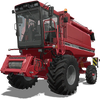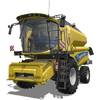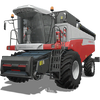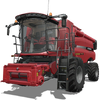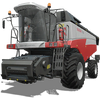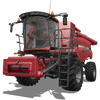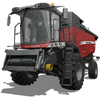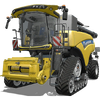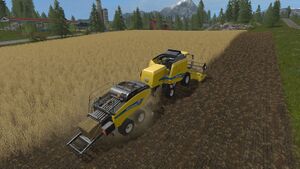Harvesters/Farming Simulator 17
- Main article: Harvesters
Harvesters are Vehicles capable of collecting fully-grown Crops from the field - including Wheat, Barley, Canola, Sunflowers, Soybeans, and Corn. A harvester must be fitted with the correct Harvesting Header for the type of Crop it is trying to collect.
The main difference between Harvester models is their Crop Capacity - the amount of Crop they can collect until full. Once full, a harvester must be unloaded - either into a Tipper or on the ground.
All Harvesters in the base game have the ability to create Straw for free while harvesting Wheat or Barley. All Harvesters have the ability to manually dump their cargo directly on the ground, creating a Pile.
Most harvesters have a Drawbar (Ball) and Drawbar (Bolt) attachment at the rear, and can therefore tow their own equipment.
Finally, unlike in previous versions of the game, every Harvester in Farming Simulator 17 can be fitted with any Header. The harvester only needs enough horsepower to operate the attached Header - otherwise it will become immobile.
List of Harvesters
Below is a list of all Harvester models in Farming Simulator 17. For a table including a comparison of cost to HP and Capacity, see Harvester Cost Efficiency.
| Name | Price | Maint. Cost per Day |
Horsepower | Max. Speed | Fuel Capacity |
Crop Capacity |
|---|---|---|---|---|---|---|
| Sampo Rosenlew Comia C6 | 124,000 | 485 | 185 | 26 km/hr
(16 mph) |
380L
(100.4gal) |
4,200L
(119bu) |
| Case IH 1660 Axial-Flow | 145,000 | 660 | 190 | 23 km/hr
(14 mph) |
350L
(92.5gal) |
6,340L
(180bu) |
| New Holland TC5.90 | 176,000 | 690 | 258 | 23 km/hr
(14 mph) |
400L
(105.7gal) |
6,400L
(182bu) |
| Massey Ferguson MF Activa 7347 S | 202,000 | 840 | 306 | 32 km/hr
(20 mph) |
620L
(163.8gal) |
8,600L
(244bu) |
| Rostselmash ACROS 595 Plus | 214,000 | 880 | 325 | 32 km/hr
(20 mph) |
540L
(142.7gal) |
9,000L
(255bu) |
| Case IH Axial-Flow 7130 | 285,000 | 1,120 | 415 | 26 km/hr
(16 mph) |
950L
(251gal) |
10,570L
(300bu) |
| Rostselmash TORUM 760 | 342,000 | 1,320 | 490 | 32 km/hr
(20 mph |
850L
(224.5gal) |
12,000L
(341bu) |
| Case IH Axial-Flow 9230 | 377,000 | 1,540 | 571 | 26 km/hr
(16 mph) |
1,000L
(264.2gal) |
12,330L
(350bu) |
| Massey Ferguson MF Delta 9380 | 385,000 | 1,580 | 496 | 32 km/hr
(20 mph) |
1,000L
(264.2gal) |
12,500L
(355bu) |
| New Holland CR10.90 | 430,000 | 1,760 | 653 | 40 km/hr
(24 mph) |
1,300L
(343.4gal) |
14,500L
(411bu) |
Harvesting
- Main article: Harvesting (Farming Simulator 17)
Harvesting is the collection of crops from a field after it is done growing. Harvesting can only be done once the plants are ready. When checking the growth-stage map in Farming Simulator 17, fields that are ready to harvest will appear yellow or orange.
A normal Harvester can collect only the following types of crops: Wheat, Barley, Corn, Canola, Soybeans and Sunflowers. Other vehicles are required for collecting other types of crops (see Forage Harvesters, Sugar Beet Combine Harvesters and Potato Combine Harvesters).
To collect any crop, a Harvester must be equipped with the correct type of Harvesting Header for that crop. With the wrong kind of header attached, the harvester will not collect anything.
During the harvesting procedure, the Harvester may become full and need to be emptied. To do so, it must first extend its pipe (Hired Workers will do this automatically). Once the pipe is out, you can use a second vehicle to tow a Tipper underneath the pipe, and the crops will be automatically unloaded into the Tipper. Alternatively, you can manually force the harvester to unload anywhere you want, creating a Pile of crop on the ground.
After harvesting, the field is ready for a new crop cycle. It will need to be Cultivated and Sown with a new crop (or the same crop), and start growing again until ready for another harvest.
The Yield from a harvest depends on whether the field has recently been Plowed and the number of times it has been Fertilized. A field can give up to double its base yield if it has been properly plowed and fertilized.
After the crops have been collected, they can be taken for sale, or stored at your Silo or dumped on the ground for later sale.
Finally, note that during the harvesting of Wheat or Barley a harvester can be set to create a Straw Swath. The straw will be left in a single line behind the harvester, and can then be picked up and used for Animal Husbandry or sold for a small extra profit at your Barn.
Harvester Categories
Even though there are only 10 Harvesters in the base game, they can be split into four different categories based on their Crop Capacity. Harvesters in each category tend to have different extra capabilities.
Small
Cargo Capacity range: 4,200 - 6,400 Liters.
Small harvesters have a very low Cargo Capacity as well as very low Horsepower. The small crop tank means that the harvester will need to be unloaded very often while harvesting. These harvesters are typically best for working a field of low-yield high-value crops, such as Canola, Soybeans and Sunflowers.
Small harvesters have a short overloading pipe; Unloading into large Tippers is impossible because the end of the pipe will collide with the Tipper's walls.
Small harvesters are low in Horsepower, and most of them cannot operate the largest headers. Nonetheless, they can still be fitted with headers much larger than the information at the store indicates.
Finally, note that two of the Small harvesters are capable of operating towed implements. Read more on this below.
Medium
Cargo Capacity range: 8,600 - 10,600 Liters.
Medium harvesters have a larger Crop Capacity than Small harvesters, allowing them to work with all kinds of crops without having to unload as often.
Medium harvesters also have a Medium-length overloading pipe, which allows them to be serviced by Tippers of any size - but a careless maneuver will easily cause a collision.
Medium Harvesters can use any Harvesting Header available in the base game without engine problems.
Large
Cargo Capacity range: 11,000 - 13,000 Liters.
Large harvesters have a very large Crop Capacity. They should be able to harvest medium-yield crops with ease, such as Wheat, Barley and Corn.
Most large harvesters have a Medium-length pipe. At least one model has a long pipe that can easily be serviced by any Tipper.
Thanks to the high Horsepower of their engines, Large harvesters can tow very heavy equipment. They can tow large Tippers with as much ease as a large Tractor could.
Super-Large
Cargo Capacity range: 14,000+ Liters.
There is only one Super-Large harvester in the game, the New Holland CR10.90. Its massive Crop Capacity makes it one of the most popular harvesters, because it does not need to stop and unload as often as other harvesters. The CR10.90 is also exceptionally fast for a harvester, allowing it to move from field to field rapidly under its own power.
On the other hand, Super-Large harvesters are much more expensive to buy and to maintain than any other harvesters.
Compatible Headers
- For a list of Harvesting Headers in Farming Simulator 17, see Harvesting Headers.
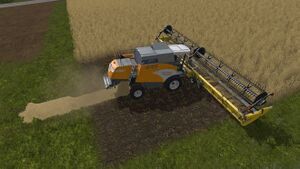
A Harvester can only perform its job when it has a Harvesting Header attached to the front.
The type of attached header determines two things:
- Which Crops the harvester can collect. If the wrong header is attached, the harvester will not collect the crop.
- The width of the harvester's working area. The wider the header, the faster the harvest.
Unlike previous versions of Farming Simulator, in Farming Simulator 17 any Harvesting Header can be attached to any Harvester - despite what the information says when buying harvesters and headers. A massive New Holland SuperFlex Draper 45FT header can be attached to a tiny Sampo Rosenlew Comia C6 harvester just fine.
However, since Headers require a certain amount of Horsepower to activate, a small harvester might not be able to move once its header is turned on if the header is too power-hungry. The smallest harvester in the base game that can move properly while fitted with the largest header is the New Holland TC5.90. Smaller harvesters can turn the header on, but will struggle to move at any speed.
Towing
Most harvesters in the base game (with the exception of the Case IH Axial-Flow 7130) have rear attachment points that can connect to trailers and implements through a Drawbar (Ball) or Drawbar (Bolt). There are many such trailers and implements in the game, including mostly Tippers and Loading Wagons, among others.
Most harvesters keep their attachment point very deep underneath the body of the harvester. As a result, they cannot connect properly to certain types of equipment. This attachment point is mostly useful for connecting to a Header Trailer, which allows the harvester to carry its own Header behind it as it moves from field to field, reducing problems when trying to cross between trees or through other narrow paths.
Most harvesters cannot provide power to their trailer (see subsection, below), but some trailers can be used without power - such as Cultivators and Plows. Therefore, with a powerful harvester, you can harvest and cultivate/plow simultaneously. This can be tricky however, because the base game only offers a limited number of cultivators and plows that have a Drawbar attachment, and none of these have the same width as any of the Harvesting Headers. Nonetheless, this can save you a lot of work in the long run, if you can get it working.
Giving Power to a Trailer
Two of the smallest harvesters, namely the Sampo Rosenlew Comia C6 and New Holland TC5.90, can actually supply power to the trailer they are towing. This enables them to activate the trailer and operate it like a Tractor would.
This ability can be used in different ways, depending on the type of trailer being towed. The most useful option is to attach a Baler or Loading Wagon behind the harvester and set it to create a Straw swath. The trailer will then automatically pick up the Straw, without the need for a second pass with another machine. Note that with Balers, you might want to select one that unloads itself automatically (e.g. a New Holland BigBaler 1290) so that you don't have to constantly stop and unload it every time it fills up.
Alternatively, a Fertilization machine can be used to fertilize the field during the harvest itself, but this can waste a lot of fertilizer.
Note that both of the harvesters mentioned above are rather weak, so they don't have much power to give to the trailer - especially when they also need to move their own weight, the trailer's weight, and power the Harvesting Header. Therefore, you'll need to find equipment that is small and light enough for the job.


